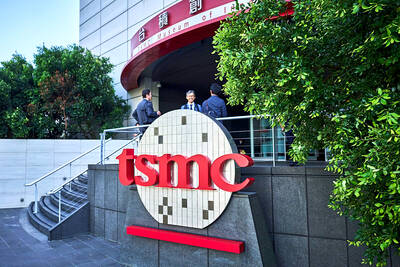A Japanese cosmetics company yesterday unveiled what it said was the world’s first spray-on skin, a moisturizing facial mask made of fibers one-100th the thickness of a human hair.
‘GREENHOUSE’
After applying an absorbent lotion, users spray the fibers onto their face and a thin translucent sheet is quickly formed, acting as a “greenhouse” for the real skin below to soak up the moisture and still be able to breathe.
The “second skin” can be worn overnight or peeled off after about a minute.
“This is the world’s first cosmetic product using such technology,” said Masayuki Uchiyama, skincare researcher at Kao Corp, the firm behind the innovation.
The hand-held diffuser was 10 years in the making, said Uchiyama, who added: “We struggled to make the device small.”
Kao researchers did not initially think of using the technology of ultra-thin fibers to create a layer on the skin, he said, adding that the precise material from which they were made was a secret.
“But we learned that the skin can still breathe under the thin fibers for many hours” in an environment akin to a greenhouse.
HIGH PRICE
Such cutting-edge tech does not come cheap though, with each diffuser costing ¥50,000 (US$460).
Nevertheless, Kao predicts cosmetic sales could reach ¥100 billion if the technology is applied to the medical field.
MEDICAL POTENTIAL
Uchiyama said it could be used to cover scars or to create an invisible medical patch.
Similar technologies already exist, including those using cells or polymer, but Uchiyama said Kao’s technology is different.
“Ours is focused on fibers. They’re more flexible and hard to break even if you move,” he said.

CAUTIOUS RECOVERY: While the manufacturing sector returned to growth amid the US-China trade truce, firms remain wary as uncertainty clouds the outlook, the CIER said The local manufacturing sector returned to expansion last month, as the official purchasing managers’ index (PMI) rose 2.1 points to 51.0, driven by a temporary easing in US-China trade tensions, the Chung-Hua Institution for Economic Research (CIER, 中華經濟研究院) said yesterday. The PMI gauges the health of the manufacturing industry, with readings above 50 indicating expansion and those below 50 signaling contraction. “Firms are not as pessimistic as they were in April, but they remain far from optimistic,” CIER president Lien Hsien-ming (連賢明) said at a news conference. The full impact of US tariff decisions is unlikely to become clear until later this month

With an approval rating of just two percent, Peruvian President Dina Boluarte might be the world’s most unpopular leader, according to pollsters. Protests greeted her rise to power 29 months ago, and have marked her entire term — joined by assorted scandals, investigations, controversies and a surge in gang violence. The 63-year-old is the target of a dozen probes, including for her alleged failure to declare gifts of luxury jewels and watches, a scandal inevitably dubbed “Rolexgate.” She is also under the microscope for a two-week undeclared absence for nose surgery — which she insists was medical, not cosmetic — and is

GROWING CONCERN: Some senior Trump administration officials opposed the UAE expansion over fears that another TSMC project could jeopardize its US investment Taiwan Semiconductor Manufacturing Co (TSMC, 台積電) is evaluating building an advanced production facility in the United Arab Emirates (UAE) and has discussed the possibility with officials in US President Donald Trump’s administration, people familiar with the matter said, in a potentially major bet on the Middle East that would only come to fruition with Washington’s approval. The company has had multiple meetings in the past few months with US Special Envoy to the Middle East Steve Witkoff and officials from MGX, an influential investment vehicle overseen by the UAE president’s brother, the people said. The conversations are a continuation of talks that

Alchip Technologies Ltd (世芯), an application-specific integrated circuit (ASIC) designer specializing in artificial-intelligence (AI) chips, yesterday said that small-volume production of 3-nanometer (nm) chips for a key customer is on track to start by the end of this year, dismissing speculation about delays in producing advanced chips. As Alchip is transitioning from 7-nanometer and 5-nanometer process technology to 3 nanometers, investors and shareholders have been closely monitoring whether the company is navigating through such transition smoothly. “We are proceeding well in [building] this generation [of chips]. It appears to me that no revision will be required. We have achieved success in designing